
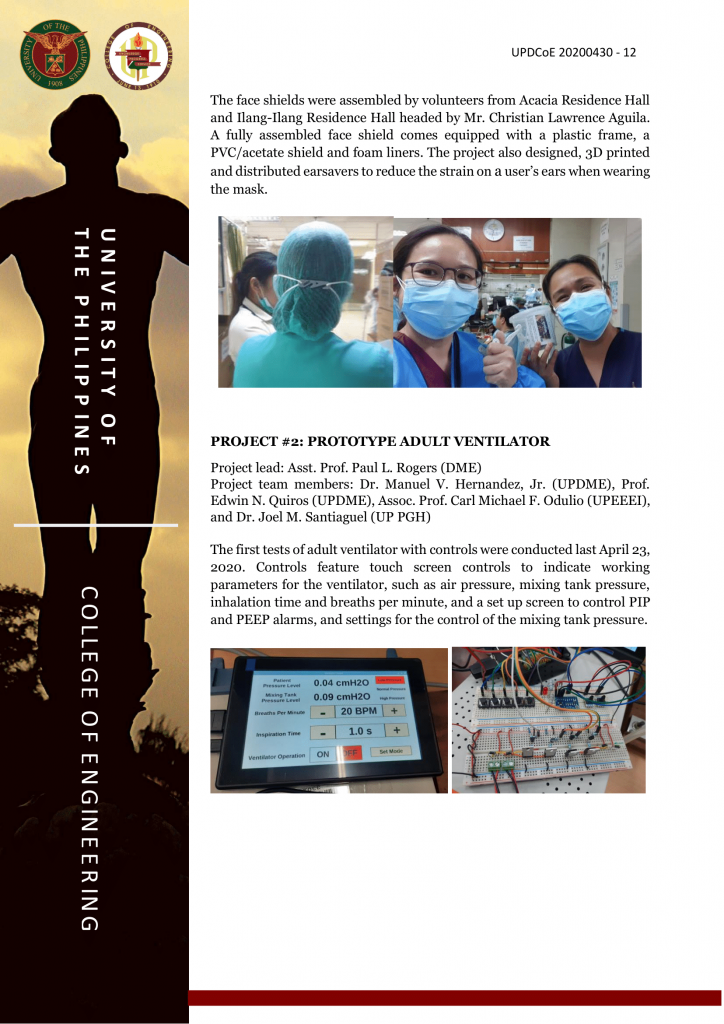
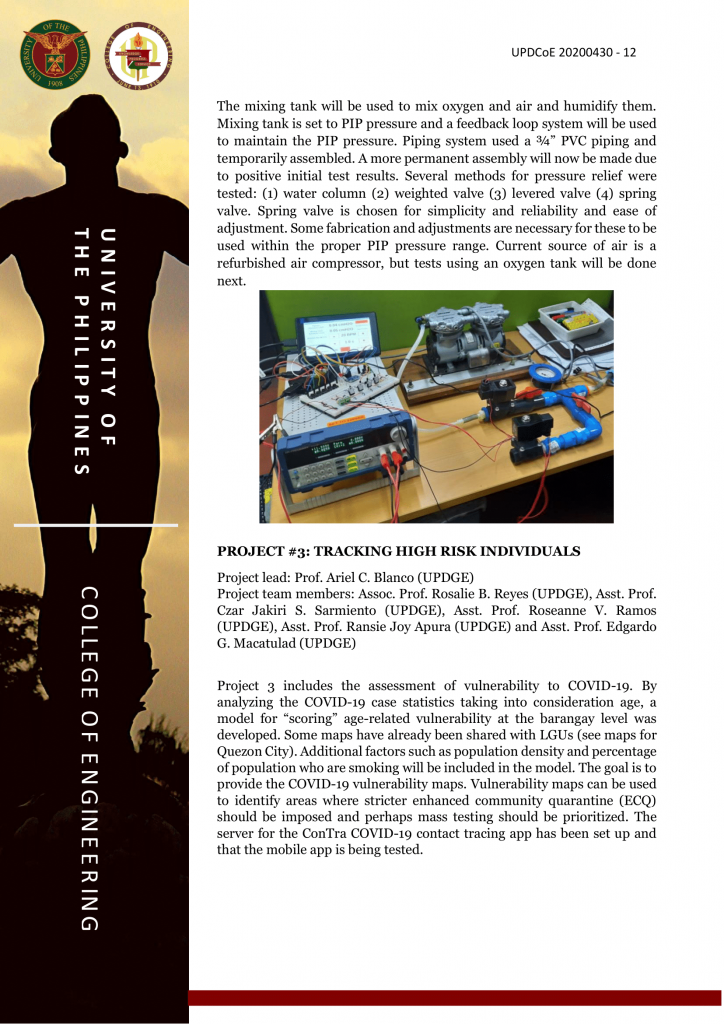


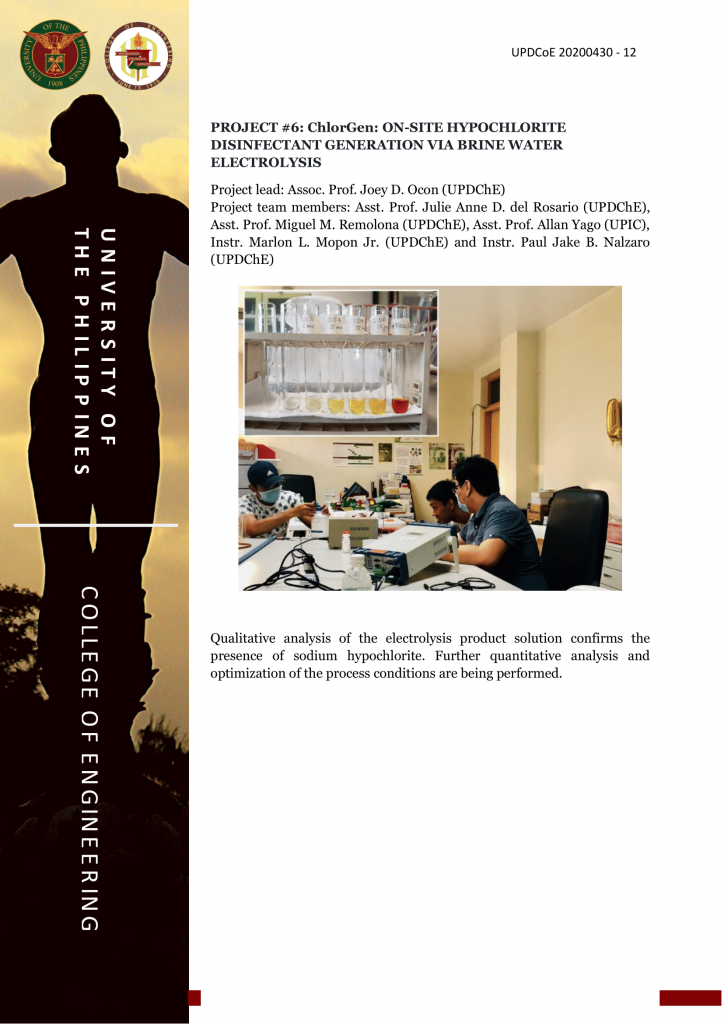
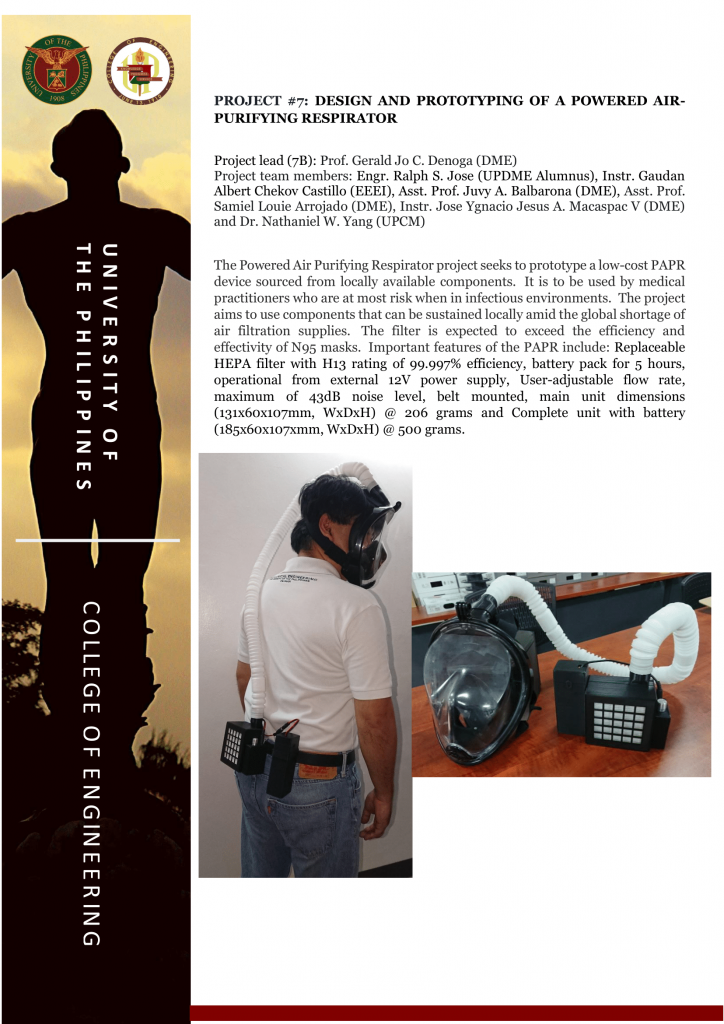
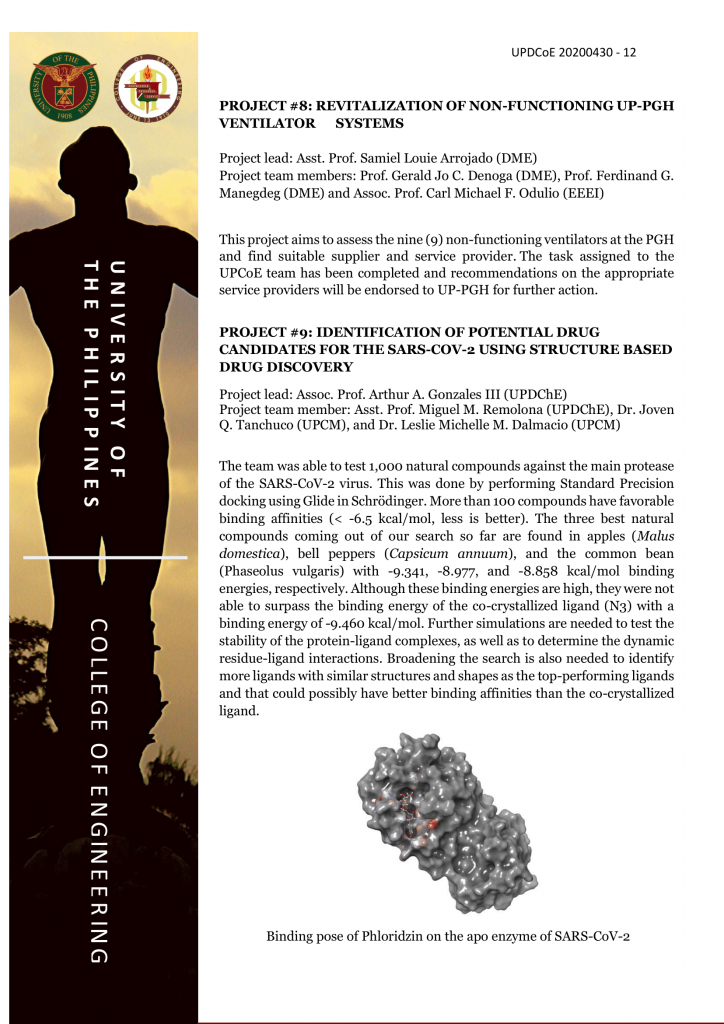
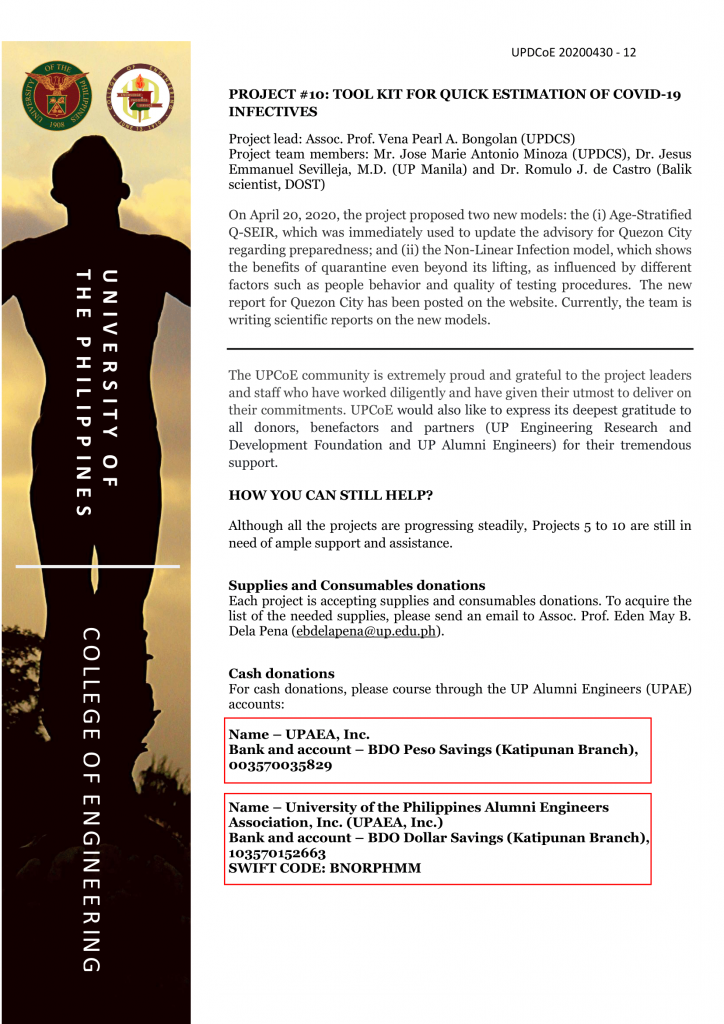

April 29, 2020
ENGINEERING SOLUTIONS TO FIGHT THE THREAT OF COVID-19 UPDATES
The following presents the most recent updates on the ten (10) UPCoE initiatives endorsed by the UPCoE COVID-19 Response Team (CRT) headed by Prof. Ferdinand G. Manegdeg (UPCoE Dean), together with Prof. Gerald Jo G. Denoga (Associate Dean for Research), Assoc. Prof. Carl Michael F. Odulio (Associate Dean for Administration), Assoc. Prof. Florencio C. Ballesteros, Jr. (Associate Dean for Instruction), Asst. Prof. Juvy A. Balbarona (Associate Dean for Student Affairs), Prof. Manolo G. Mena (NGSE Director), Assoc. Prof. Eligia D. Clemente (College Secretary) and Assoc. Prof. Eden May B. dela Peña (Associate Dean for Public Service) to help fight the threat of the COVID-19 pandemic.
PROJECT #1: 3D PRINTING SOLUTIONS FOR OUR FRONTLINERS
Project lead: Prof. Gerald Jo G. Denoga (UPDME)
Project team members: Prof. Michael Angelo A. Pedrasa (UPEEEI), Asst. Prof. Mario Carreon (UPDCS) and Mr. Erik Lacson (Meta-Tech)
As of April 27, 2020, the project has fabricated two thousand three hundred seventy five (2,375) pieces of face shield frames using seventeen (17) 3D printers, assembled one thousand eight hundred fifty four (1,854) complete face shields, and distributed one thousand six hundred fifty four (1,654) of the finished product to 31 different hospitals in Metro Manila, Pangasinan, Baguio, Laguna, Batangas and Cavite.
The face shield frame design was based on the 3D4AC 1.4.2 design and modified for improved comfort, better sealing and easier assembly.
The face shields were assembled by volunteers from Acacia Residence Hall and Ilang-Ilang Residence Hall headed by Mr. Christian Lawrence Aguila. A fully assembled face shield comes equipped with a plastic frame, a PVC/acetate shield and foam liners. The project also designed, 3D printed and distributed earsavers to reduce the strain on a user’s ears when wearing the mask.
PROJECT #2: PROTOTYPE ADULT VENTILATOR
Project lead: Asst. Prof. Paul L. Rogers (DME)
Project team members: Dr. Manuel V. Hernandez, Jr. (UPDME), Prof. Edwin N. Quiros (UPDME), Assoc. Prof. Carl Michael F. Odulio (UPEEEI), and Dr. Joel M. Santiaguel (UP PGH)
The first test of adult ventilator with controls were conducted last April 23, 2020. Controls feature touch screen controls to indicate working parameters for the ventilator, such as air pressure, mixing tank pressure, inhalation time and breaths per minute, and a set up screen to control PIP and PEEP alarms, and settings for the control of the mixing tank pressure.
The mixing tank will be used to mix oxygen and air and humidify them. Mixing tank is set to PIP pressure and a feedback loop system will be used to maintain the PIP pressure. Piping system used a ¾” PVC piping and temporarily assembled. A more permanent assembly will now be made due to positive initial test results. Several methods for pressure relief were tested: (1) water column (2) weighted valve (3) levered valve (4) spring valve. Spring valve is chosen for simplicity and reliability and ease of adjustment. Some fabrication and adjustments are necessary for these to be used within the proper PIP pressure range. Current source of air is a refurbished air compressor, but tests using an oxygen tank will be done next.
PROJECT #3: TRACKING HIGH RISK INDIVIDUALS
Project lead: Prof. Ariel C. Blanco (UPDGE)
Project team members: Assoc. Prof. Rosalie B. Reyes (UPDGE), Asst. Prof. Czar Jakiri S. Sarmiento (UPDGE), Asst. Prof. Roseanne V. Ramos (UPDGE), Asst. Prof. Ransie Joy Apura (UPDGE) and Asst. Prof. Edgardo G. Macatulad (UPDGE)
Project 3 includes the assessment of vulnerability to COVID-19. By analyzing the COVID-19 case statistics taking into consideration age, a model for “scoring” age-related vulnerability at the barangay level was developed. Some maps have already been shared with LGUs (see maps for Quezon City). Additional factors such as population density and percentage of population who are smoking will be included in the model. The goal is to provide the COVID-19 vulnerability maps. Vulnerability maps can be used to identify areas where stricter enhanced community quarantine (ECQ) should be imposed and perhaps mass testing should be prioritized. The server for the ConTra COVID-19 contact tracing app has been set up and that the mobile app is being tested.
PROJECT #4: DISINFECTION AND DECONTAMINATION THROUGH PLASMA CLEANING
Project lead: Assoc. Prof. Magdaleno R. Vasquez, Jr. (UPDMMME)
Project team members: Asst. Prof. Katrina Lois M. Taaca (UPDMMME) and Assoc. Prof. Eduardo R. Magdaluyo (UPDMMME)
Plasma was ignited using a 13.56 MHz radio frequency (RF) power source (Fig.1(a)). Argon (Ar) was used as the gas with operating pressures varied from 100 to 200 Pa. Incident RF was from 50 to 100 W. Unfortunately, a crack on the glass chamber reemerged that made it difficult to achieve a better vacuum. The chamber is undergoing repair and will be subjected to leak testing. Another system was also tested for generating plasma. This time it is powered by microwave energy. Ar plasma at 150 to 300 Pa was successfully ignited shown in the image below, but the operating time is very short because of overheating concerns.
PROJECT #5: DISINFECTION OF PPE VIA UV LIGHT
Project lead: Prof. Florencio C. Ballesteros, Jr. (UPDChE) and Assoc. Prof. Eligia D. Clemente (UPDMMME)
Project team members: Prof. Ferdinand G. Manegdeg (UPDME), Prof. Annaliza P. Rollon (UPEnE) and Dr. Louernie de Sales-Papa (UPEnE)
The group has completed two (2) prototypes that are currently being tested for efficiency of disinfection. Parallel tests will be done at UP PGH. These cabinets can accommodate 2 to 4 gowns or coveralls and 8 to 16 masks. A third prototype changes the format of the chamber to fit in 6 coveralls and make the time of exposure faster. A box diagram is shown below. The current designs conform to the theoretical design parameters indicated in the handbook for UV disinfection.
PROJECT #6: ChlorGen: ON-SITE HYPOCHLORITE DISINFECTANT GENERATION VIA BRINE WATER ELECTROLYSIS
Project lead: Assoc. Prof. Joey D. Ocon (UPDChE)
Project team members: Asst. Prof. Julie Anne D. del Rosario (UPDChE), Asst. Prof. Miguel M. Remolona (UPDChE), Asst. Prof. Allan Yago (UPIC), Instr. Marlon L. Mopon Jr. (UPDChE) and Instr. Paul Jake B. Nalzaro (UPDChE)
Qualitative analysis of the electrolysis product solution confirms the presence of sodium hypochlorite. Further quantitative analysis and optimization of the process conditions are being performed.
PROJECT #7: DESIGN AND PROTOTYPING OF A POWERED AIR-PURIFYING RESPIRATOR
Project lead (7B): Prof. Gerald Jo C. Denoga (DME)
Project team members: Engr. Ralph S. Jose (UPDME Alumnus), Instr. Gaudan Albert Chekov Castillo (EEEI), Asst. Prof. Juvy A. Balbarona (DME), Asst. Prof. Samiel Louie Arrojado (DME), Instr. Jose Ygnacio Jesus A. Macaspac V (DME) and Dr. Nathaniel W. Yang (UPCM)
The Powered Air Purifying Respirator project seeks to prototype a low-cost PAPR device sourced from locally available components. It is to be used by medical practitioners who are at most risk when in infectious environments. The project aims to use components that can be sustained locally amid the global shortage of air filtration supplies. The filter is expected to exceed the efficiency and effectivity of N95 masks. Important features of the PAPR include: Replaceable HEPA filter with H13 rating of 99.997% efficiency, battery pack for 5 hours, operational from external 12V power supply, User-adjustable flow rate, maximum of 43dB noise level, belt mounted, main unit dimensions (131x60x107mm, WxDxH) @ 206 grams and Complete unit with battery (185x60x107xmm, WxDxH) @ 500 grams.
PROJECT #8: REVITALIZATION OF NON-FUNCTIONING UP-PGH VENTILATOR SYSTEMS
Project lead: Asst. Prof. Samiel Louie Arrojado (DME)
Project team members: Prof. Gerald Jo C. Denoga (DME), Prof. Ferdinand G. Manegdeg (DME) and Assoc. Prof. Carl Michael F. Odulio (EEEI)
This project aims to assess the nine (9) non-functioning ventilators at the PGH and find suitable supplier and service provider. The task assigned to the UPCoE team has been completed and recommendations on the appropriate service providers will be endorsed to UP-PGH for further action.
PROJECT #9: IDENTIFICATION OF POTENTIAL DRUG CANDIDATES FOR THE SARS-COV-2 USING STRUCTURE BASED DRUG DISCOVERY
Project lead: Assoc. Prof. Arthur A. Gonzales III (UPDChE)
Project team member: Asst. Prof. Miguel M. Remolona (UPDChE), Dr. Joven Q. Tanchuco (UPCM), and Dr. Leslie Michelle M. Dalmacio (UPCM)
The team was able to test 1,000 natural compounds against the main protease of the SARS-CoV-2 virus. This was done by performing Standard Precision docking using Glide in Schrödinger. More than 100 compounds have favorable binding affinities (< -6.5 kcal/mol, less is better). The three best natural compounds coming out of our search so far are found in apples (Malus domestica), bell peppers (Capsicum annuum), and the common bean (Phaseolus vulgaris) with -9.341, -8.977, and -8.858 kcal/mol binding energies, respectively. Although these binding energies are high, they were not able to surpass the binding energy of the co-crystallized ligand (N3) with a binding energy of -9.460 kcal/mol. Further simulations are needed to test the stability of the protein-ligand complexes, as well as to determine the dynamic residue-ligand interactions. Broadening the search is also needed to identify more ligands with similar structures and shapes as the top performing ligands and that could possibly have better binding affinities than the co-crystallized ligand.
PROJECT #10: TOOL KIT FOR QUICK ESTIMATION OF COVID-19 INFECTIVES
Project lead: Assoc. Prof. Vena Pearl A. Bongolan (UPDCS)
Project team members: Mr. Jose Marie Antonio Minoza (UPDCS), Dr. Jesus Emmanuel Sevilleja, M.D. (UP Manila) and Dr. Romulo J. de Castro (Balik scientist, DOST)
On April 20, 2020, the project proposed two new models: the (i) Age-Stratified Q-SEIR, which was immediately used to update the advisory for Quezon City regarding preparedness; and (ii) the Non-Linear Infection model, which shows the benefits of quarantine even beyond its lifting, as influenced by different factors such as people behavior and quality of testing procedures. The new report for Quezon City has been posted on the website. Currently, the team is writing scientific reports on the new models.
The UPCoE community is extremely proud and grateful to the project leaders and staff who have worked diligently and have given their utmost to deliver on their commitments. UPCoE would also like to express its deepest gratitude to all donors, benefactors and partners (UP Engineering Research and Development Foundation and UP Alumni Engineers) for their tremendous support.
HOW YOU CAN STILL HELP?
Although all the projects are progressing steadily, however Projects 5 to 10 are still in need of ample support and assistance.
Supplies and Consumables donations
Each project is accepting supplies and consumables donations. To acquire the list of the needed supplies, please send an email to Assoc. Prof. Eden May B. Dela Pena (ebdelapena@up.edu.ph).
Cash donations
For cash donations, please course through the UP Alumni Engineers (UPAE) accounts:
Name – UPAEA, Inc.
Bank and account – BDO Peso Savings (Katipunan Branch), 003570035829
Name – University of the Philippines Alumni Engineers Association, Inc. (UPAEA, Inc.)
Bank and account – BDO Dollar Savings (Katipunan Branch), 103570152663
SWIFT CODE: BNORPHMM
Kindly send a copy of the deposit slip, or a screenshot of the electronic transaction, to Assoc. Prof. Eden May B. dela Peña ebdelapena@up.edu.ph, Associate Dean for Public Service College of Engineering UP Diliman, for accounting purposes. Donations will be acknowledged accordingly, and an audited report will be emailed to our donors.
Furthermore, for suggestions and enquiries on the different projects, send an email to Assoc. Prof. Eden May B. dela Peña at ebdelapena@up.edu.ph.
May our concerted efforts see us through this challenging time. We continue to wish for everyone’s safety, health and well-being.

